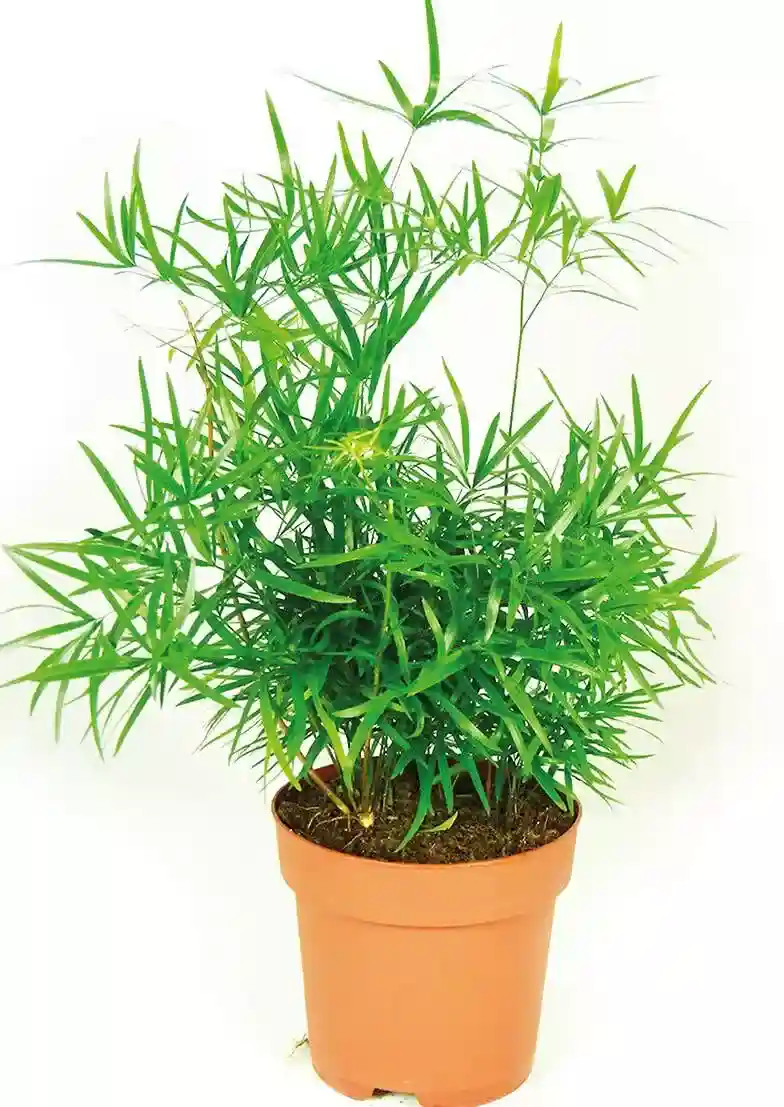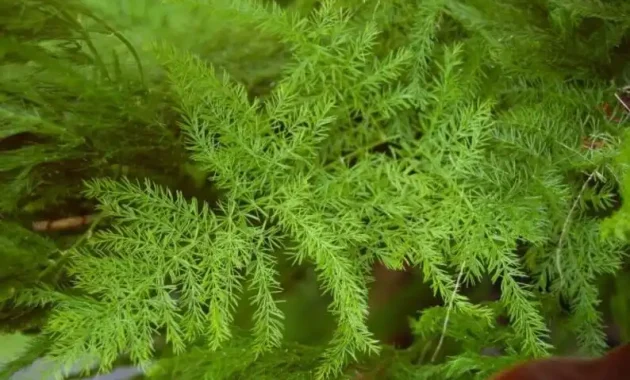Are you looking for a low-maintenance houseplant that can bring beauty and freshness to your indoor space? Look no further than the asparagus fern!
Asparagus ferns, also known as Asparagus densiflorus, are perfect for those with busy schedules or little gardening experience. With their unique varieties like Foxtail fern and Sprengeri fern, these plants can add a touch of elegance to any room.
They thrive in humid environments, making them ideal for bathrooms or kitchens. Just mist them daily or place them in a tray of water to keep them happy. These ferns love bright but indirect light and should be watered when the top inch of soil is dry.
Plus, they require minimal pruning and only need repotting every couple of years. However, it’s important to note that asparagus ferns are toxic to pets, so handle with care!
Whether you choose to grow them indoors in hanging baskets or outdoors under partial shade, these versatile plants will surely brighten up your living space all year round.
Types of Asparagus Ferns
There are several types of asparagus ferns, each with their own unique characteristics and care requirements. Popular varieties include the Foxtail fern, Plumosa fern, Sprengeri fern, and Sicklethorn fern.
Foxtail Fern
The foxtail fern brings whimsical nature indoors with its bushy, fluffy foliage. This easy-going plant is actually a variety of asparagus fern, despite its furry look.
In the wilds of South Africa, its homeland, the foxtail fern sprouts clusters of small white blooms in summer. These flowers transform into gleaming red berries by fall. Though alluring, the berries aren’t for snacking, because they can be toxic.

While the foxtail fern thrives outdoors in warm climates, it also makes the perfect houseplant for spaces lacking in greenery. Those bottlebrush plumes do more than look cozy – they filter toxins from indoor air.
Caring for a foxtail is simple, with ample sunlight, moderate watering, and occasional feeding. Propagating new ferns through division or seeds is a breeze.
With foxtail ferns, you can have a playful hint of nature without high maintenance. Just watch those stems around pets, as they can poke curious noses.
Bring the outdoors in with a foxtail fern and breathe easy as it purifies your home’s environment.
Plumosa Fern
While named a fern, the plumosa is actually an herb hailing from Southern Africa. This climbing beauty vines its way upwards with wandering stems reaching several meters long. Along those supple shoots are leaves made to mimic true ferns, with lacy leaflets that unfurl in airy clusters.

Though delicate in appearance, mature plumosa ferns grow tough woody stems lined with spikes for climbing. Beyond its graceful charm, this plant naturally filters and purifies indoor air.
Plumosa thrives as a carefree houseplant in bright, indirect light with routine watering. Use a peat-based potting mix and keep the soil consistently moist, not soaked. Propagating plumosa through cuttings or division is a breeze. Repot whenever it outgrows its container.
In floral arrangements, plumosa brings lightweight texture as filler. Its airy greenery and easygoing nature make plumosa fern a lovely living accent. Display one in your home and let it lend tranquil ambiance while improving your indoor air quality.
Sprengeri Fern
This fountain-like beauty cascades gracefully in hanging baskets or planters. Sprengeri fern is a variety of asparagus from South Africa, known for arching stems adorned with fine needle leaves. Tiny white blooms appear in summer, followed by gleaming red berries. While lush and full, mature stems develop sharp thorns to beware of.

Beyond its flowing tresses, sprengeri naturally filters indoor air and provides anti-inflammatory benefits.
Caring for this plant is simple with bright, indirect light and routine watering. Use a peaty potting mix and keep soil consistently moist, not soaked. Propagation is easy by division or root cuttings. Repot whenever sprengeri outgrows its container.
With its easygoing nature and graceful drape, sprengeri fern brings elegance without fuss. Display one in your home to enhance spaces with refined texture and naturally cleaner air. Just take care around those thorny stems!
Sicklethorn Fern
Sicklethorn Fern, also known as Asparagus falcatus, is a large, thorny, climbing plant that is native to Mozambique and the forests of South Africa. It is not a true fern but a member of the Asparagaceae family.

The plant has sickle-shaped leaves and the stems are distinctly prickly, hence the common name. Sicklethorn Fern thrives in medium to bright, indirect light, cool to average warmth, and moderately moist, rich, well-drained soils. It prefers to be grown in a slightly acidic, well-drained, peat moss-based potting mix.
During the growing season, it thrives on consistently moist soil, but not too damp that will cause root rot.
Sicklethorn Fern is commonly used as an ornamental plant and is grown as a houseplant in colder climates. It is also used in the cut-flower industry as a bouquet filler.
The plant is relatively easy to propagate through root division or seeds.
To care for Sicklethorn Fern, it is important to spray the leaves daily with lime-free water in the summer and once a week in the spring, fertilize with mineral fertilizer every 15 days in spring and summer, and with manure or compost in late winter, and prune to keep it neat and tidy as well as reduce pest and disease infestations.
Ideal Growing Conditions
To create the ideal conditions for growing asparagus ferns, you’ll want to find a bright spot near a window, away from direct sun or drafts. Asparagus ferns love humidity, so placing them in the bathroom or kitchen where moisture levels are higher can be beneficial. To increase humidity, mist the plants daily or use a tray of water nearby.
When it comes to watering frequency, wait until the top inch of soil is dry before watering your asparagus fern. Overwatering can lead to root rot, so it’s important not to let the plant sit in soggy soil. During active growth in spring and summer, fertilize your fern with a balanced houseplant fertilizer.
Pruning old and dead stems at the base will help keep your asparagus fern looking tidy and promote new growth. Repotting every two years and dividing if needed will ensure that your plant has enough space to grow.
For potting soil recommendations, a well-draining mix with organic matter works best for asparagus ferns. Lastly, if you’re growing your fern outdoors, make sure to bring it indoors before temperatures drop below 50 degrees Fahrenheit for overwintering strategies.
| Propagation Methods | Watering Frequency | Fertilizing Requirements | |
|---|---|---|---|
| 1 | Division | When top inch is dry | Spring and Summer |
| 2 | Seeds | ||
| 3 | Rhizome Cuttings |
Remember that asparagus ferns can cause skin irritation and are toxic to cats and dogs. Handle them with gloves and keep them out of reach of pets.
Indoor Care Tips
If you want your indoor plants to thrive, it’s important to provide them with the right conditions and care. When it comes to asparagus ferns, there are a few key things to keep in mind.
First, watering frequency is crucial. These ferns prefer their soil to be slightly dry before watering, so make sure to wait until the top inch of soil is dry before giving them a drink.
As for fertilizer requirements, it’s best to fertilize during their active growth period in spring and summer. Use a balanced fertilizer at half strength every 2-4 weeks.
When it comes to pruning techniques, you’ll want to remove any dead or yellowing stems at the base of the plant. This will help promote new growth and keep your fern looking fresh and healthy. Repotting guidelines suggest repotting your asparagus fern every 2 years or when it becomes root-bound. If needed, you can also divide the plant during this time.
Humidity is another important factor for these plants. Asparagus ferns love humidity, so misting them daily or placing them near a tray of water will help increase moisture levels around the plant. However, be cautious about handling these ferns as they can cause skin irritation. It’s best to wear gloves when touching them.
Lastly, it’s essential to note that asparagus ferns are toxic to cats and dogs. So if you have pets in your home, make sure they can’t access these plants or consider choosing a pet-friendly alternative instead.
Outdoor Care Tips
Growing asparagus ferns outdoors provides a beautiful and lush addition to your garden, with their arching branches and feathery foliage swaying in the breeze. To ensure their health and vitality, here are some important care tips for growing asparagus ferns outdoors:
- Outdoor Watering: Asparagus ferns prefer consistently moist soil but do not like to sit in waterlogged conditions. Water deeply when the top inch of soil feels dry, allowing excess water to drain away.
- Temperature Requirements: These ferns thrive in temperatures between 60-75 degrees Fahrenheit (15-24 degrees Celsius). Bring them indoors before temperatures drop below 50 degrees Fahrenheit (10 degrees Celsius) to protect them from frost.
- Transitioning Indoors: As winter approaches, it’s essential to bring your outdoor asparagus ferns indoors. Place them near a window where they can still receive bright indirect light and continue watering them regularly.
In addition to these care tips, consider planting your asparagus fern in a hanging basket for an eye-catching display or use it as ground cover in your outdoor landscape. They prefer well-draining soil that is rich in organic matter and slightly acidic. Pruning techniques involve removing old or dead stems at the base to encourage new growth and maintain its attractive appearance.
By following these guidelines, you can enjoy thriving asparagus ferns both indoors and outdoors throughout the year.
Common Pests and Diseases
Dealing with pesky invaders and diseases can be a challenge for any plant, and asparagus ferns are no exception. When it comes to pest control, common pests that may affect your asparagus fern include mites, slugs, aphids, and mealybugs. Regularly inspect your plants for signs of these pests and take appropriate measures to eliminate them. This can include using insecticidal soap or neem oil.
In addition to pests, fungal infections can also pose a threat to your asparagus fern. Leaf spot and root or crown rot are common fungal diseases that can cause leaf discoloration and wilting of the plant. To prevent these infections, make sure you provide adequate air circulation around the plant by avoiding overcrowding and watering at the base of the plant instead of overhead.
Pruning techniques can also help in preventing pest infestations and controlling diseases. Remove any dead or yellowing leaves regularly to maintain a healthy plant. Additionally, pruning back overgrown stems can promote new growth and prevent the spread of diseases.
Soil pH levels play an important role in the overall health of your asparagus fern. These plants prefer slightly acidic to neutral soil pH levels ranging from 6.0 to 7.0. Regularly test your soil’s pH levels and adjust accordingly using amendments if necessary.
Lastly, watering frequency is crucial for keeping your asparagus fern healthy. While they love humidity, overwatering can lead to root rot and other fungal infections. Water when the top inch of soil is dry but avoid letting the plant sit in standing water.
By following proper pest control methods, monitoring for fungal infections, practicing pruning techniques, maintaining appropriate soil pH levels, and watering correctly, you will be well on your way to ensuring a thriving asparagus fern garden!
Propagation Methods
To expand your collection of asparagus ferns, try using various propagation methods that can be both fun and rewarding! Here are three effective ways to propagate your asparagus ferns:
- Water Propagation: Start by taking a healthy stem cutting from the parent plant and place it in a jar filled with water. Make sure to remove any lower leaves that may touch the water. Keep the jar in a warm and bright location, changing the water every few days. After a few weeks, you will notice roots starting to form. Once the roots are about an inch long, you can transfer the cutting into a pot with well-draining soil.
- Division Techniques: Asparagus ferns can also be propagated through division. Carefully remove the plant from its pot and gently separate the root ball into smaller sections, making sure each section has some roots attached. Replant these divisions in separate pots with fresh soil and water thoroughly.
- Seed Germination: Collect ripe berries from your existing plants and extract their seeds by squeezing them out onto a paper towel. Allow them to dry for a few days before planting them in seed-starting mix or peat pots. Keep the soil consistently moist and provide warmth and bright light for optimal germination.
Remember to be patient when propagating asparagus ferns as it may take some time for new growth to appear. Have fun experimenting with these different propagation methods and enjoy expanding your collection of this beautiful plant!
Interesting Facts and Varieties
Did you know that there are different varieties of asparagus ferns, each with their own unique characteristics and growth habits? Let’s explore some interesting facts about these varieties and discover the beauty they can bring to your indoor or outdoor space!
One fascinating aspect of asparagus ferns is their use in floral arrangements. With their feathery-like, fern-like foliage, they add a touch of elegance and texture to bouquets and centerpieces. However, it’s important to note that these plants are toxic to pets, so be cautious when placing them in areas accessible to your furry friends.
When it comes to winter survival, asparagus ferns have a few tips up their sleeves. If you’re growing them outdoors, make sure to bring them indoors before temperatures drop below 50 degrees Fahrenheit. By planting them indoors during the colder months, you’ll help them survive winter and thrive once spring arrives.
For those who prefer hanging baskets as a way to showcase their green companions, asparagus ferns are an ideal choice. Their arching habit and delicate foliage create a cascading effect that adds beauty and interest to any space.
To keep your asparagus fern looking its best, proper pruning techniques should be followed. Remove old or dead stems at the base of the plant to encourage new growth and maintain its shape.
When it comes time for repotting, aim for every two years or when needed. Dividing the plant if it has become too large will promote healthier growth.
So whether you’re looking for an addition to your floral arrangements or want a stunning hanging basket plant, consider one of the many varieties of asparagus ferns available. With proper care and attention, these plants can bring joy and beauty into your home or garden space!
Conclusion
To conclude, taking care of asparagus ferns is a rewarding and relatively easy task. They thrive in bathroom or kitchen environments due to their love for humidity. Remember to mist them daily or place them near water to increase humidity.
Keep them near a window but away from direct sun or heat sources. This will ensure they receive enough light without getting burned. Watering should be done when the top inch of soil is dry. This will prevent overwatering and root rot. Additionally, pruning old stems regularly will help maintain the plant’s shape and promote new growth.
It is important to repot asparagus ferns every two years to provide fresh soil and room for growth. However, be cautious of their toxicity to pets. If you have furry friends, it’s best to keep the ferns out of their reach.
Whether you choose to keep them indoors or outdoors, make sure they are in partial shade. This will protect them from intense sunlight and help them thrive. So go ahead and enjoy the beauty of these ferns in your home or garden!


